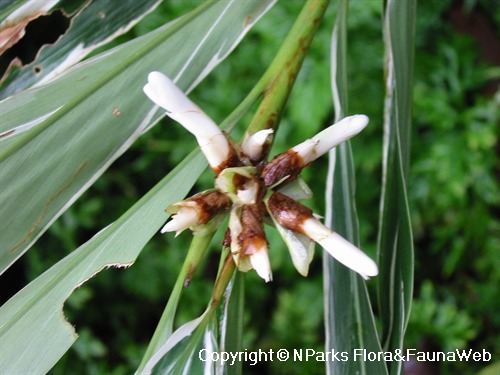
Name
Classifications and Characteristics
| Plant Division | Angiosperms (Flowering Seed Plants) (Monocotyledon) |
|---|---|
| Plant Growth Form | Herbaceous Plant |
| Lifespan (in Singapore) | Perennial |
| Mode of Nutrition | Autotrophic |
Biogeography
| Native Distribution | Philippines |
|---|---|
| Native Habitat | Terrestrial |
Description and Ethnobotany
| Growth Form | It is a bamboo-looking rhizomatous herb, growing about 1.5 m in height. |
|---|---|
| Foliage | Its leaves are lanceolate, green on the upper surface, reddish underside. |
| Flowers | The inflorescence is borne terminal at the ends of branches. The individual flower is creamy white, with bright red calyxes. |
| Fruit | The fruits are oval, yellow at maturity. |
| Etymology | The genus Alpinia is named after Prospero Alpino, a 16th-century physician and botanist. Luteocarpa means yellow fruits. |
Landscaping Features
| Desirable Plant Features | Ornamental Flowers, Ornamental Form |
|---|---|
| Landscape Uses | Parks & Gardens, Small Gardens |
Fauna, Pollination and Dispersal
| Pollination Method(s) | Biotic (Fauna) |
|---|---|
| Seed or Spore Dispersal | Biotic (Fauna) |
Plant Care and Propagation
| Light Preference | Semi-Shade |
|---|---|
| Water Preference | Moderate Water |
| Rootzone Tolerance | Moist Soils |
| Propagation Method | Division |
Foliar
| Foliage Retention | Evergreen |
|---|---|
| Mature Foliage Colour(s) | Green, Pink |
| Leaf Area Index (LAI) for Green Plot Ratio | 3.5 (Shrub & Groundcover - Monocot) |
| Mature Foliage Colour(s) Remarks | Leaves dark green with purplish pink margin |
Floral (Angiosperm)
| Flower Colour(s) | Red, Cream / Off-White |
|---|---|
| Flower Grouping | Cluster / Inflorescence |
| Flower Location | Terminal |
| Flowering Period | Free-Flowering |
| Flowering Opening Time | Time-Independent |
Fruit, Seed and Spore
| Mature Fruit Colour(s) | Yellow / Golden |
|---|
Image Repository
Others
| Master ID | 29113 |
|---|---|
| Species ID | 3425 |
| Flora Disclaimer | The information in this website has been compiled from reliable sources, such as reference works on medicinal plants. It is not a substitute for medical advice or treatment and NParks does not purport to provide any medical advice. Readers should always consult his/her physician before using or consuming a plant for medicinal purposes. |





.jpg)
.jpg)

.jpg)

